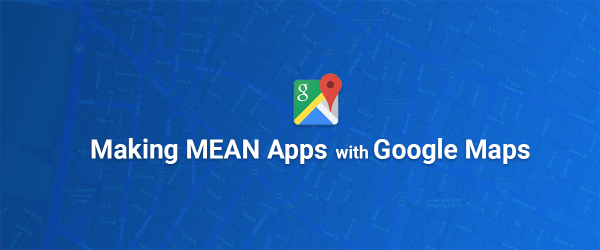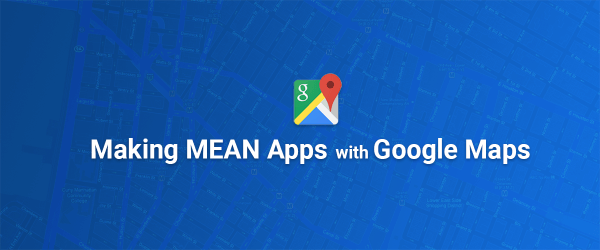
Introduction
“MEAN Apps with Google Maps” (A tongue twister to be true).
And yet, whether you’re building an application to visualize bike lanes in your city, designing a tool to chart oil wells across the globe, or are simply creating an app to help choose your next date — having access to interactive, data-rich maps can be a critical asset. Thus, in this two-part tutorial, we’ll be writing code that directly integrates Google Maps with the views, controllers, and data of a MEAN-based application.
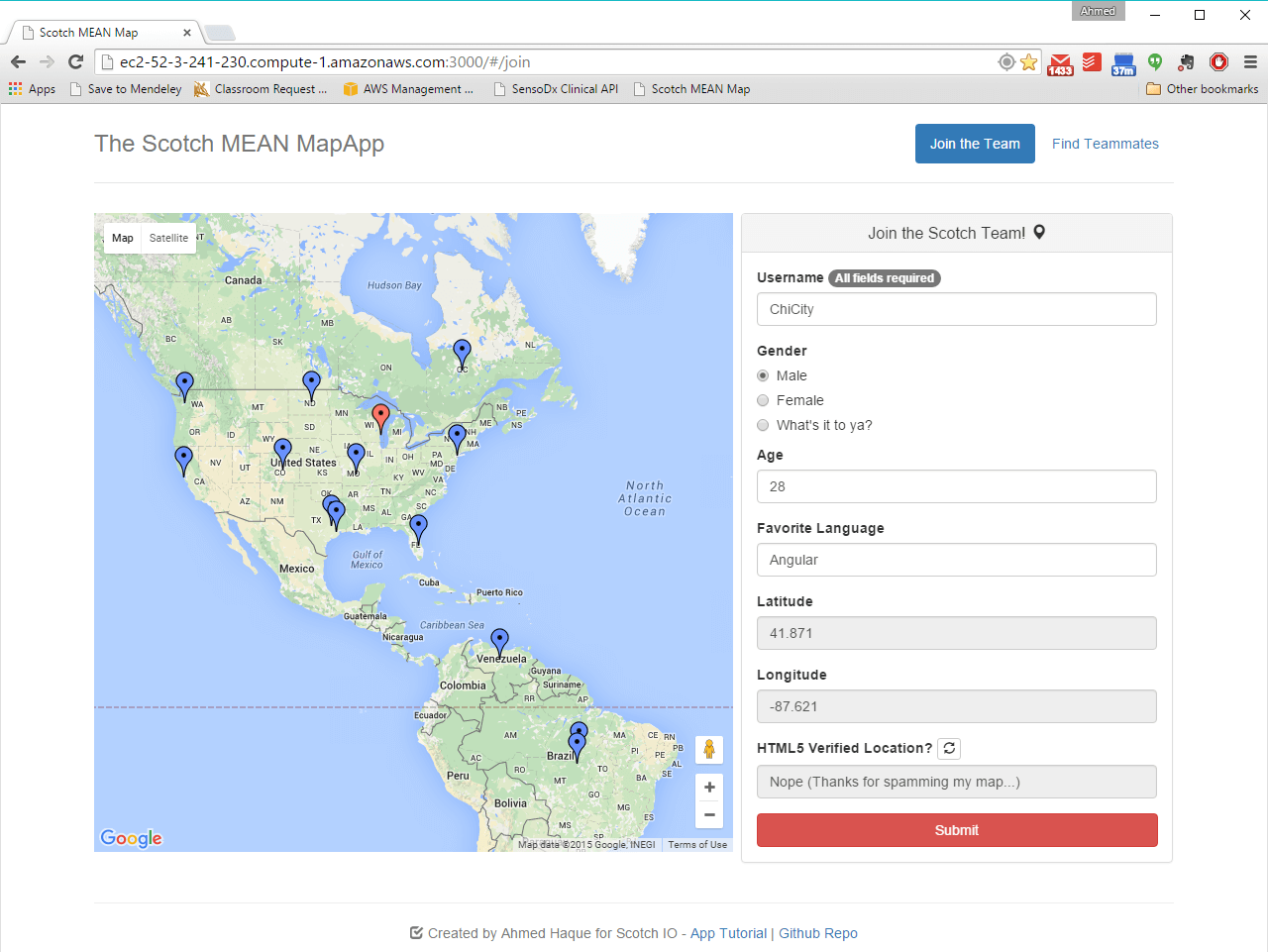
In Part I of the tutorial, we’ll be building the initial interface and data-binding the HTML and Angular elements with MongoDB and Google Maps. In Part II of the tutorial, we’ll be utilizing MongoDB’s geospatial and other querying tools to create complex filters on the map itself.
As you follow along, feel encouraged to grab the source code in the link provided. Just note: The code found in the Github link has a few additional tweaks compared to today’s tutorial. To get an exact replica of what we’re building today, use the TutorialMaterial/PartI link.
Intro to the Google Maps API
As the title clearly suggests, we’ll be using the Google Maps Javascript API throughout. The API is richly documented, easy to learn, and free for low-volume usage. It may be worth flipping through the documentation guides now to see what’s possible. Once you’re ready to begin, head to the API homepage and sign-up to “Get a Key”. Simply follow the instructions for creating a Project and you will be granted a unique API key. Hang onto this key!

Once you have your key, head to the APIs section of the Google Developer Console and click the link to the Google Maps Javascript API. Make sure the API is Enabled under your new Project. (If it says: “Disable API” then you’re good).
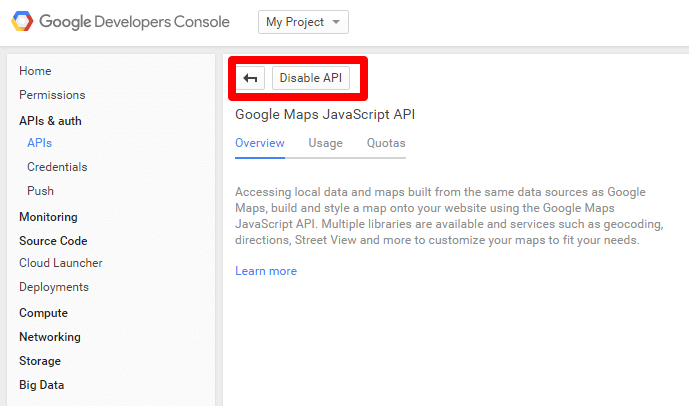
Overall App Skeleton
The final product we’ll build is a basic two panel application. On the left is a map and on the right is a control panel. In this first part of the tutorial, the control panel will be used to add new users to the map. (In the second part, the control panel will also be used to filter the map results).
Before we start working, go ahead and create an app directory as follows:
MapApp
-- app
// Backend
---- model.js
---- routes.js
-- public
// Frontend
---- index.html
---- js
------ app.js
------ addCtrl.js
------ gservice.js
---- style.css
-- server.js
// Express Server
-- package.json We’ll try to keep things simple throughout. The app will be composed of three sections:
- A frontend handling what’s displayed to the user,
- A controller and factory for AJAX calls and maintaining the Google Map,
- A server and database for hosting user data
Grabbing Dependencies and Setting up the HTML
Once you’re ready, run the following commands in your terminal to grab the necessary dependencies from bower:
bower install angular-route#1.4.6 bower install angularjs-geolocation#0.1.1 bower install bootstrap#3.3.5 bower install modernizr#3.0.0 Next, add the following content to your package.json file
{ "name": "MeanMapsApp",
"main": "server.js",
"dependencies" : {
"express" : "~4.7.2",
"mongoose" : "~4.1.0",
"morgan" : "~1.2.2",
"body-parser": "~1.5.2",
"jsonwebtoken": "^5.0.2",
"method-override": "~2.1.2" }
} Then, run npm install to install the relevant node packages.
Now, replace the content of your index.html file with the content below. There’s nothing too fancy here, so just paste and wait for the explanation after.
<!doctype html> <!-- Declares meanMapApp as the starting Angular module --> <html class="no-js" ng-app="meanMapApp"> <head> <meta charset="utf-8"> <title>Scotch MEAN Map</title> <meta name="description" content="An example demonstrating Google Map integration with MEAN Apps"> <meta name="viewport" content="width=device-width, initial-scale=1"> <!-- CSS --> <link rel="stylesheet" href="http://feeds.feedblitz.com/~/t/0/0/scotch_io/~https://scotch.io/bower_components/bootstrap/dist/css/bootstrap.css"/> <link rel="stylesheet" href="http://feeds.feedblitz.com/~/t/0/0/scotch_io/~style.css"/> <!-- Holder JS --> <script src="https://scotch.io/bower_components/holderjs/holder.js"></script> <!-- Google Maps API --> <script src="https://maps.googleapis.com/maps/api/js?key=YOUR_API_HERE"></script> <!-- Modernizr --> <script src="https://scotch.io/bower_components/modernizr/bin/modernizr"></script> <!-- JS Source --> <script src="https://scotch.io/bower_components/jquery/jquery.js"></script> <script src="https://scotch.io/bower_components/angular/angular.js"></script> <script src="https://scotch.io/bower_components/angular-route/angular-route.js"></script> <script src="https://scotch.io/bower_components/angularjs-geolocation/dist/angularjs-geolocation.min.js"></script> </head> <body> <div class="container"> <div class="header"> <ul class="nav nav-pills pull-right"> <li active><a href="">Join the Team</a></li> <li disabled><a href="">Find Teammates</a></li> </ul> <h3 class="text-muted">The Scotch MEAN MapApp</h3> </div> <!-- Map and Side Panel --> <div class="row content"> <!-- Google Map --> <div class="col-md-7"> <div id="map"><img src="holder.js/645x645"></div> </div> <!-- Side Panel --> <div class="col-md-5"> <div class="panel panel-default"> <!-- Panel Title --> <div class="panel-heading"> <h2 class="panel-title text-center">Join the Scotch Team! <span class="glyphicon glyphicon-map-marker"></span></h2> </div> <!-- Panel Body --> <div class="panel-body"> <!-- Creates Form (novalidate disables HTML validation, Angular will control) --> <form name ="addForm" novalidate> <!-- Text Boxes and Other User Inputs. Note ng-model binds the values to Angular $ scope --> <div class="form-group"> <label for="username">Username <span class="badge">All fields required</span></label> <input type="text" class="form-control" id="username" placeholder="OldandGold" ng-model="formData.username" required> </div> <label class="radio control-label">Gender</label> <div class="radio"> <label> <input type="radio" name="optionsRadios" id="radiomale" value="Male" ng-model="formData.gender"> Male </label> </div> <div class="radio" required> <label> <input type="radio" name="optionsRadios" id="radiofemale" value="Female" ng-model="formData.gender"> Female </label> </div> <div class="radio"> <label> <input type="radio" name="optionsRadios" id="radioother" value="What's it to ya?" ng-model="formData.gender"> What's it to ya? </label> </div> <div class="form-group"> <label for="age">Age</label> <input type="number" class="form-control" id="age" placeholder="72" ng-model="formData.age" required> </div> <div class="form-group"> <label for="language">Favorite Language</label> <input type="text" class="form-control" id="language" placeholder="Fortran" ng-model="formData.favlang" required> </div> <div class="form-group"> <label for="latitude">Latitude</label> <input type="text" class="form-control" id="latitude" value="39.500" ng-model="formData.latitude" readonly> </div> <div class="form-group"> <label for="longitude">Longitude</label> <input type="text" class="form-control" id="longitude" value="-98.350" ng-model="formData.longitude" readonly> </div> <div class="form-group"> <label for="verified">HTML5 Verified Location? <span><button class="btn btn-default btn-xs"><span class="glyphicon glyphicon-refresh"></span></button></span></label> <input type="text" class="form-control" id="verified" placeholder= "Nope (Thanks for spamming my map...)" ng-model="formData.htmlverified" readonly> </div> <!-- Submit button. Note that its tied to createUser() function from addCtrl. Also note ng-disabled logic which prevents early submits. --> <button type="submit" class="btn btn-danger btn-block" ng-disabled="addForm.$ invalid">Submit</button> </form> </div> </div> </div> </div> <hr/> <!-- Footer --> <div class="footer"> <p class="text-center"><span class="glyphicon glyphicon-check"></span> Created by Ahmed Haque for Scotch IO - <a href="http://feeds.feedblitz.com/~/t/0/0/scotch_io/~https://scotch.io/">App Tutorial</a> | <a href="http://feeds.feedblitz.com/~/t/0/0/scotch_io/~https://github.com/afhaque/MeanMapAppV2.0">Github Repo</a></p> </div> </div> </body> </html>
At this point, we have a basic HTML page with a div for a map and a div with an HTML form for adding users. That said, there are a few things to note:
- We’ve included a link to the Google Maps API at the top of the page. Be sure to insert your own API into the script!
- We’ve included the Angular directive
ng-app = meanMapAppat the top of the page. We’ll use this to reference our Angular module later on. - We’re using a temporary holderjs image in place of our map for now. This will let us get a quick visual of what we have.
- We’ve included a
noValidateattribute in the HTML form element. This disables HTML form validation. Instead, we’ll be using Angular to validate our form. - Most importantly, note the repeated use of
ng-modelthroughout the form. Each of these takes content in a textbox or control element and uses it to set the value of an associated property in the scope variableformData. So if a user sets his username to be “WackaWackaMan”, then the variable$ scope.formData.usernamewould equal “WackaWackaMan” as well. - Lastly, note the function
ng-disabled="addForm.$ invalid". This will prevent a user from clicking the Submit button unless the form is completely valid. In our case, since all fields have the attribute ofrequired, this means that all fields will need to be populated before the button is enabled.
See. Nothing fancy!
But at this point, you should be able to do a quick browser inspection.
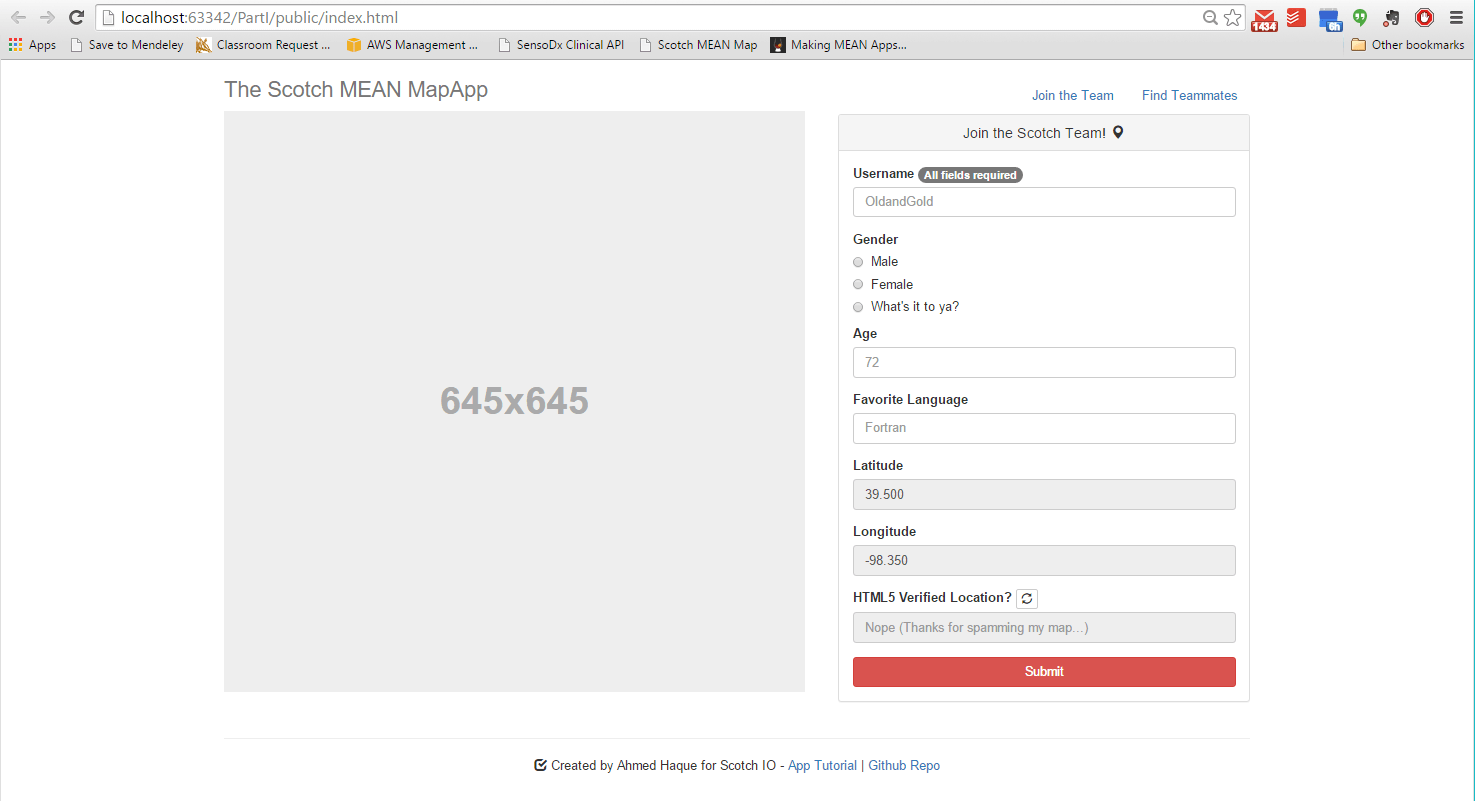
Setting up the Node/Express Server
Now that we have an initial HTML template, it’s time to create the Node and Express server that will handle GET and POST requests for data. Paste the below code in the server.js file. This code is a great template for building quick express servers, so keep it handy. It includes morgan for handling request logs, body-parser for parsing JSON POST bodies, and specifies the location of the index.html file and bower_components.
Worth noting is that the server is configured to use localhost:3000 in displaying the app and that we’ll be connecting to a local instance of MongoDB. (Remember, since we’re running this in localhost to always initiate Mongod during testing).
// Dependencies // -----------------------------------------------------
var express = require('express');
var mongoose = require('mongoose');
var port = process.env.PORT || 3000;
var morgan = require('morgan');
var bodyParser = require('body-parser');
var methodOverride = require('method-override');
var app = express();
// Express Configuration // -----------------------------------------------------
// Sets the connection to MongoDB mongoose.connect("mongodb://localhost/MeanMapApp");
// Logging and Parsing app.use(express.static(__dirname + '/public'));
// sets the static files location to public app.use('/bower_components', express.static(__dirname + '/bower_components'));
// Use BowerComponents app.use(morgan('dev'));
// log with Morgan app.use(bodyParser.json());
// parse application/json app.use(bodyParser.urlencoded({extended: true}));
// parse application/x-www-form-urlencoded app.use(bodyParser.text());
// allows bodyParser to look at raw text app.use(bodyParser.json({ type: 'application/vnd.api+json'}));
// parse application/vnd.api+json as json app.use(methodOverride());
// Routes // ------------------------------------------------------ //
require('./app/routes.js')(app);
// Listen // -------------------------------------------------------
app.listen(port); console.log('App listening on port ' + port); Boot up mongod in the terminal. Then run a quick test of the server using the command node server.js in your terminal window. If all goes well, you should see our earlier HTML content when you navigate to localhost:3000 in your browser.
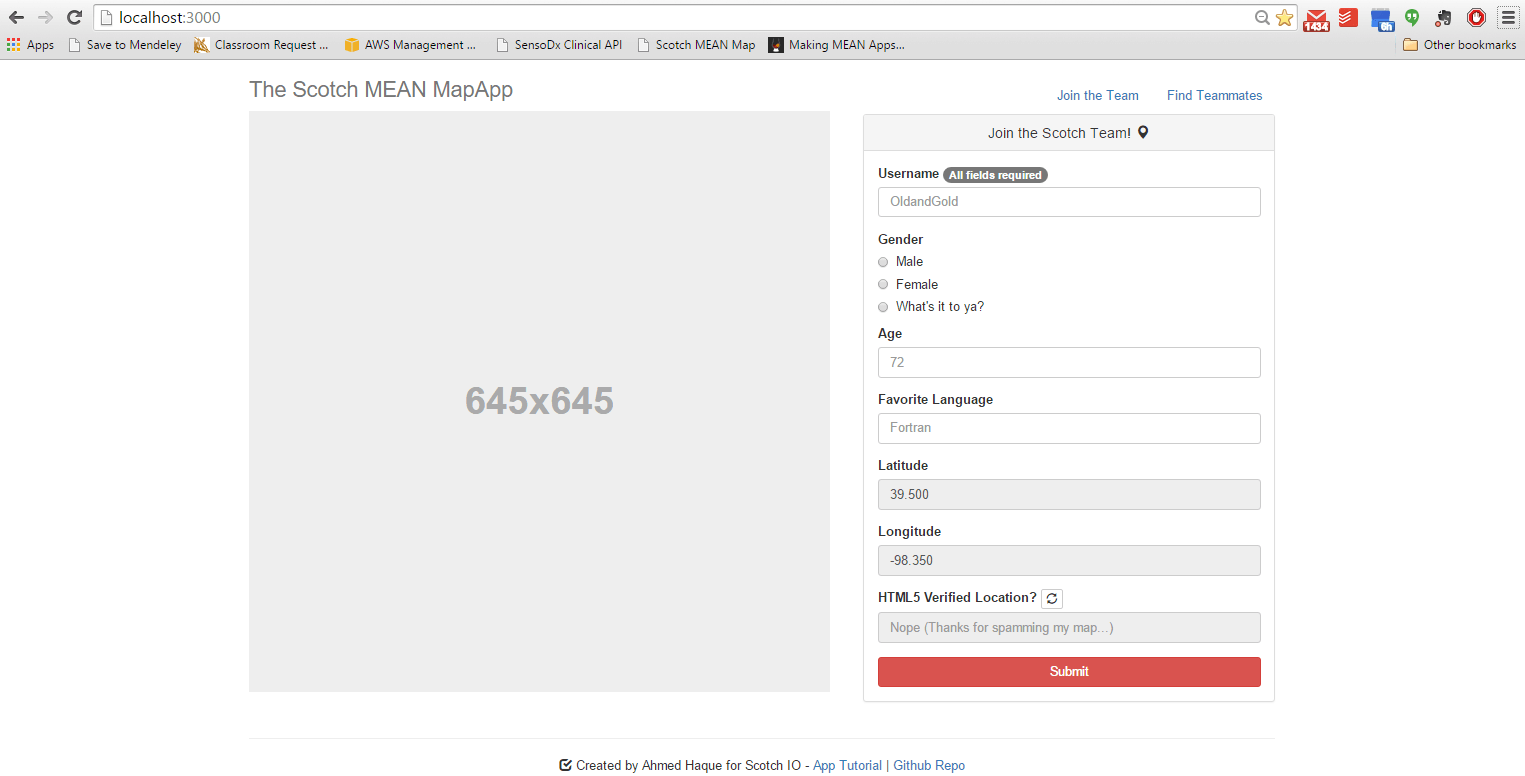
Create the Mongoose Schema
Next up, let’s create a Mongoose Schema that we can use to interact with the user data we’ll be dumping into MongoDB. Navigate to your model.js file and paste the following code
// Pulls Mongoose dependency for creating schemas var mongoose = require('mongoose');
var Schema = mongoose.Schema;
// Creates a User Schema. This will be the basis of how user data is stored in the db var UserSchema = new Schema({ username: {type: String, required: true}, gender: {type: String, required: true}, age: {type: Number, required: true}, favlang: {type: String, required: true}, location: {type: [Number], required: true}, // [Long, Lat] htmlverified: String, created_at: {type: Date, default: Date.now}, updated_at: {type: Date, default: Date.now} }); // Sets the created_at parameter equal to the current time UserSchema.pre('save', function(next){ now = new Date(); this.updated_at = now; if(!this.created_at) { this.created_at = now } next(); }); // Indexes this schema in 2dsphere format (critical for running proximity searches) UserSchema.index({location: '2dsphere'}); // Exports the UserSchema for use elsewhere. Sets the MongoDB collection to be used as: "scotch-users" module.exports = mongoose.model('scotch-user', UserSchema); Here we’ve established the structure we’ll be expecting (and enforcing) our user JSON to maintain. As you can see, we’re expecting six different fields:
Username,Gender,Age,Favorite language,- Whether or not a user’s location has been
html5 verified
We’ve also created pre-save logic which initially sets the created_at and updated_at fields equal to the datetime of insertion.
Importantly, we’ve also established that the UserSchema should be indexed using a 2dsphere approach. This line is critical, because it allows MongoDB and Mongoose to run geospatial queries on our user data. This means being able to query users based on geographic inclusion, intersection, and proximity. Check out the reference docs on 2dsphere indexes for more information. As an example, we’ll be using the $ near query condition in Part II to identify users that fall within so many miles of a given location.
Also, important is the fact that MongoDB requires coordinates to be ordered in [Long, Lat] format. (Backwards-seeming. I know. But very important.) This is especially important to remember because Google Maps requires coordinates in the other direction [Lat, Long]. Just try to keep things straight as you’re working.
Finally, the model.js file ends, with us exporting the Mongoose model and establishing a MongoDB collection of scotch-users as the holding location for our data. (Note: “scotch-users” isn’t a typo. Mongoose adds an extra letter ‘s’ when creating collections).
Setup the Routes + Server + Testing the API
We’re making great progress! Next up, we need to create the Express routes for retrieving and creating new users in our MongoDB database. For the purpose of this tutorial, we’re going to create the bare minimum routes: one route to retrieve a list of all users (GET) and one route to add new users (POST). Paste the below code in your routes.js file to set this up.
// Dependencies var mongoose = require('mongoose'); var User = require('./model.js'); // Opens App Routes module.exports = function(app) { // GET Routes // -------------------------------------------------------- // Retrieve records for all users in the db app.get('/users', function(req, res){ // Uses Mongoose schema to run the search (empty conditions) var query = User.find({}); query.exec(function(err, users){ if(err) res.send(err); // If no errors are found, it responds with a JSON of all users res.json(users); }); }); // POST Routes // -------------------------------------------------------- // Provides method for saving new users in the db app.post('/users', function(req, res){ // Creates a new User based on the Mongoose schema and the post bo.dy var newuser = new User(req.body); // New User is saved in the db. newuser.save(function(err){ if(err) res.send(err); // If no errors are found, it responds with a JSON of the new user res.json(req.body); }); }); }; Then, in your server.js file, uncomment the line associated with routing to connect our routes to the server:
require('./app/routes.js')(app); Things to note here:
- We’re declaring our Mongoose model (here titled: “User”) created earlier as a dependency. In the subsequent GET and POST routes we use Mongoose and the User model to query for records and create new records with simple syntax. We create users using the line:
var newuser = new User(req.body);and retrieve all users with the linevar query = User.find({});. (Note: These users are NOT yet added to our map. We’re just dealing with the MongoDB database at this point.) - We’re using the route
/userfor both the GET and POST requests. At any point during testing we can direct our browser tolocalhost:3000/usersto see what’s in the database.
Speaking of testing, now’s a good time to test the routes. Let’s open up Postman (or a similar HTTP testing client) and run two tests.
First, let’s run a POST request to create a new user. Paste the below content into the body of a POST request and send it to localhost:3000/users. Remember to set the content type to “Raw” and “JSON (application/json)” before sending.

{ "username": "scotcher", "gender": "Female", "age": "25", "favlang": "Javascript", "location": [-95.56, 29.735] } Once you’ve sent the request, navigate your browser to localhost:3000/users. If all went well, you should see the JSON you just sent, displayed before you.
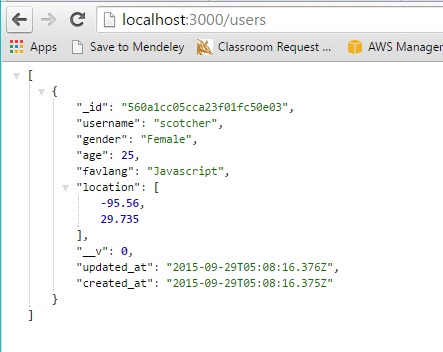
Huzzah!
Create the Add Controller
We’re slowly but surely clawing forward. Now it’s time to bring in Angular. First things first, let’s declare the intial angular module in public->js->app.js. This file will serve as the starting Angular module. Once again, let’s keep it simple.
// Declares the initial angular module "meanMapApp". Module grabs other controllers and services. var app = angular.module('meanMapApp', ['addCtrl', 'geolocation']); For now the module will pull only from addCtrl (the controller for our Add User Form) and geolocation, a module we downloaded earlier through Bower. We’ll be using the ‘Geolocation’ module to provide a user’s HTML5 verified location later.
Next, let’s open up the addCtrl.js file and begin creating our controller. Let’s begin with the basics: creating the function needed to add users to our database.
// Creates the addCtrl Module and Controller. Note that it depends on the 'geolocation' module and service. var addCtrl = angular.module('addCtrl', ['geolocation']); addCtrl.controller('addCtrl', function($ scope, $ http, geolocation){ // Initializes Variables // ---------------------------------------------------------------------------- $ scope.formData = {}; var coords = {}; var lat = 0; var long = 0; // Set initial coordinates to the center of the US $ scope.formData.latitude = 39.500; $ scope.formData.longitude = -98.350; // Functions // ---------------------------------------------------------------------------- // Creates a new user based on the form fields $ scope.createUser = function() { // Grabs all of the text box fields var userData = { username: $ scope.formData.username, gender: $ scope.formData.gender, age: $ scope.formData.age, favlang: $ scope.formData.favlang, location: [$ scope.formData.longitude, $ scope.formData.latitude], htmlverified: $ scope.formData.htmlverified }; // Saves the user data to the db $ http.post('/users', userData) .success(function (data) { // Once complete, clear the form (except location) $ scope.formData.username = ""; $ scope.formData.gender = ""; $ scope.formData.age = ""; $ scope.formData.favlang = ""; }) .error(function (data) { console.log('Error: ' + data); }); }; }); The logic here is straightforward if you’ve worked with Angular before, but for those who haven’t, the code essentially refers back to each of the textboxes and control elements using the $ scope.formData.VAR format. These are initially set to blanks (except location, which has initial dummy numbers).
Once a user hits a button associated with the createUser() function, the Angular controller initiates a process of grabbing each of the textbox and control values and storing them in the object userData. From there, an http post request is made to the '/users route we created earlier. The form is cleared (except for location) and the function completes.
The next step is for us to return to our index.html file and attach our “Submit” button to the controller. To do this we need to make two modifications to our index.html file.
First, we need to include the scripts associated with app.js and addCtrl.js in our index.html file.
<!-- Angular Scripts --> <script src="js/app.js"></script> <script src="js/addCtrl.js"></script> Then, we need to attach our addCtrl controller to the HTML body.
<body ng-controller="addCtrl"> Next, we need to attach our createUser() function through the “Submit” button’s ng-click event.
<button type="submit" class="btn btn-danger btn-block" ng-click="createUser()" ng-disabled="addForm.$ invalid">Submit</button> Great. Now it’s time to run a quick test. Fire up your server using node server.js then navigate to localhost:3000. At this point, try adding users via the HTML form. If everything’s been coded correctly, you should be able to see your newest user on the localhost:3000/users page.
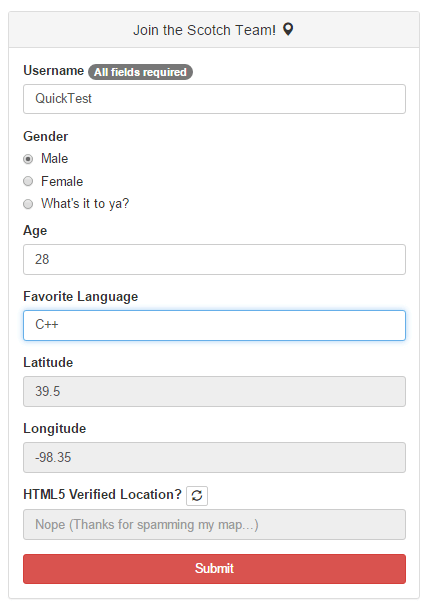
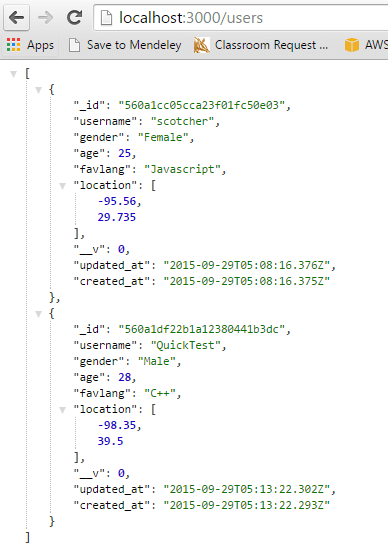
Eureka! Now onto the real reason you’re here….
Create the Google Maps Factory Service
Maps! This is where things get tricky. So follow closely.
At a high-level, what we need to do next is to take the user data we’ve collected to this point… 1) Convert each into a Google Maps readable format and 2) Drop Google Map markers to the correct coordinates. Additionally, we’re going to need to build functionality for pop-ups and clickable map coordinates.
To handle all of this, we’re going to create a new Angular Factory. This factory will be used by our addCtrl controller to complete all of the logic associated with map building.
Go ahead and open your public->app->gservice.js file. Then paste the below code in place.
// Creates the gservice factory. This will be the primary means by which we interact with Google Maps angular.module('gservice', []) .factory('gservice', function($ http){ // Initialize Variables // ------------------------------------------------------------- // Service our factory will return var googleMapService = {}; // Array of locations obtained from API calls var locations = []; // Selected Location (initialize to center of America) var selectedLat = 39.50; var selectedLong = -98.35; // Functions // -------------------------------------------------------------- // Refresh the Map with new data. Function will take new latitude and longitude coordinates. googleMapService.refresh = function(latitude, longitude){ // Clears the holding array of locations locations = []; // Set the selected lat and long equal to the ones provided on the refresh() call selectedLat = latitude; selectedLong = longitude; // Perform an AJAX call to get all of the records in the db. $ http.get('/users').success(function(response){ // Convert the results into Google Map Format locations = convertToMapPoints(response); // Then initialize the map. initialize(latitude, longitude); }).error(function(){}); }; // Private Inner Functions // -------------------------------------------------------------- // Convert a JSON of users into map points var convertToMapPoints = function(response){ // Clear the locations holder var locations = []; // Loop through all of the JSON entries provided in the response for(var i= 0; i < response.length; i++) { var user = response[i]; // Create popup windows for each record var contentString = '<p><b>Username</b>: ' + user.username + '<br><b>Age</b>: ' + user.age + '<br><b>Gender</b>: ' + user.gender + '<br><b>Favorite Language</b>: ' + user.favlang + '</p>'; // Converts each of the JSON records into Google Maps Location format (Note [Lat, Lng] format). locations.push({ latlon: new google.maps.LatLng(user.location[1], user.location[0]), message: new google.maps.InfoWindow({ content: contentString, maxWidth: 320 }), username: user.username, gender: user.gender, age: user.age, favlang: user.favlang }); } // location is now an array populated with records in Google Maps format return locations; }; // Initializes the map var initialize = function(latitude, longitude) { // Uses the selected lat, long as starting point var myLatLng = {lat: selectedLat, lng: selectedLong}; // If map has not been created already... if (!map){ // Create a new map and place in the index.html page var map = new google.maps.Map(document.getElementById('map'), { zoom: 3, center: myLatLng }); } // Loop through each location in the array and place a marker locations.forEach(function(n, i){ var marker = new google.maps.Marker({ position: n.latlon, map: map, title: "Big Map", icon: "http://maps.google.com/mapfiles/ms/icons/blue-dot.png", }); // For each marker created, add a listener that checks for clicks google.maps.event.addListener(marker, 'click', function(e){ // When clicked, open the selected marker's message currentSelectedMarker = n; n.message.open(map, marker); }); }); // Set initial location as a bouncing red marker var initialLocation = new google.maps.LatLng(latitude, longitude); var marker = new google.maps.Marker({ position: initialLocation, animation: google.maps.Animation.BOUNCE, map: map, icon: 'http://maps.google.com/mapfiles/ms/icons/red-dot.png' }); lastMarker = marker; }; // Refresh the page upon window load. Use the initial latitude and longitude google.maps.event.addDomListener(window, 'load', googleMapService.refresh(selectedLat, selectedLong)); return googleMapService; }); Let’s breakdown what’s going on in here.
1) First, we created a generic Angular module and factory called gservice and specified that it depends on the$ http service.
2) We initialized a set of key variables:
- The
googleMapServiceobject that will hold therefreshfunction we’ll use to rebuild the map, - The
locationsarray which will hold all of the converted locations in the database. - The
selectedLatandselectedLongvariables, which hold the specific location we’re looking at during any point in time.
3) We then created a refresh() function, which takes new coordinate data and uses it to refresh the map. To do this, the function performs an AJAX call to the database and pulls all of the saved records. It then takes these records and passes them to a function called convertToMapPoints, which loops through each record — creating an array of Google formatted coordinates with pre-built pop-up messages. (Note that Google formats its coordinates [Lat, Long], so we needed to flip the order from how we saved things in MongoDb).
4) Once the values have been converted, the refresh function sets off the initialize() function. This function, creates a generic Google Map and places it in the index.html file where the div id of map exists. The initialize function, then loops through each of the locations in the locations array and places a blue-dot marker on that location’s geographic position. These markers are each given a listener that opens their message boxes on click. Finally, the initialize() function ends with a bouncing red marker being placed at the initial location (pre-set to center of America as of now).
5) The refresh() function is run immediately upon window load, allowing the map to be seen right away.
If you’re still with me, then let’s incorporate our gservice and refresh() functions in the rest of the app. Since we’ll be using the refresh() function whenever we add a new user, it makes sense to include it in our addCtrl.js file.
Modify the initial call in addCtrl so it includes both the gservice module and factory.
var addCtrl = angular.module('addCtrl', ['geolocation', 'gservice']); addCtrl.controller('addCtrl', function($ scope, $ http, geolocation, gservice){ ... Additionally, add the below line in the $ http.post function beneath the lines where the form is cleared. This will immediately refresh the map when a new user is added.
// Logic for Clearing the FOrm // ... // Refresh the map with new data gservice.refresh($ scope.formData.latitude, $ scope.formData.longitude); Next add the gservice module to our main app.js file.
var app = angular.module('meanMapApp', ['addCtrl', 'geolocation', 'gservice']); Then add the ‘gservice’ script to our index.html file and delete the reference to our holder image.
<script src="js/gservice.js"></script> <!-- Google Map --> <div class="col-md-7"> <div id="map"><img src="holder.js/645x645"></div> </div> And finally… it’s time to test. Fire up your server.js and let’s see what localhost:3000 looks like now. If all went well, you should be seeing two blue dots correlating to the two users we added to your database.
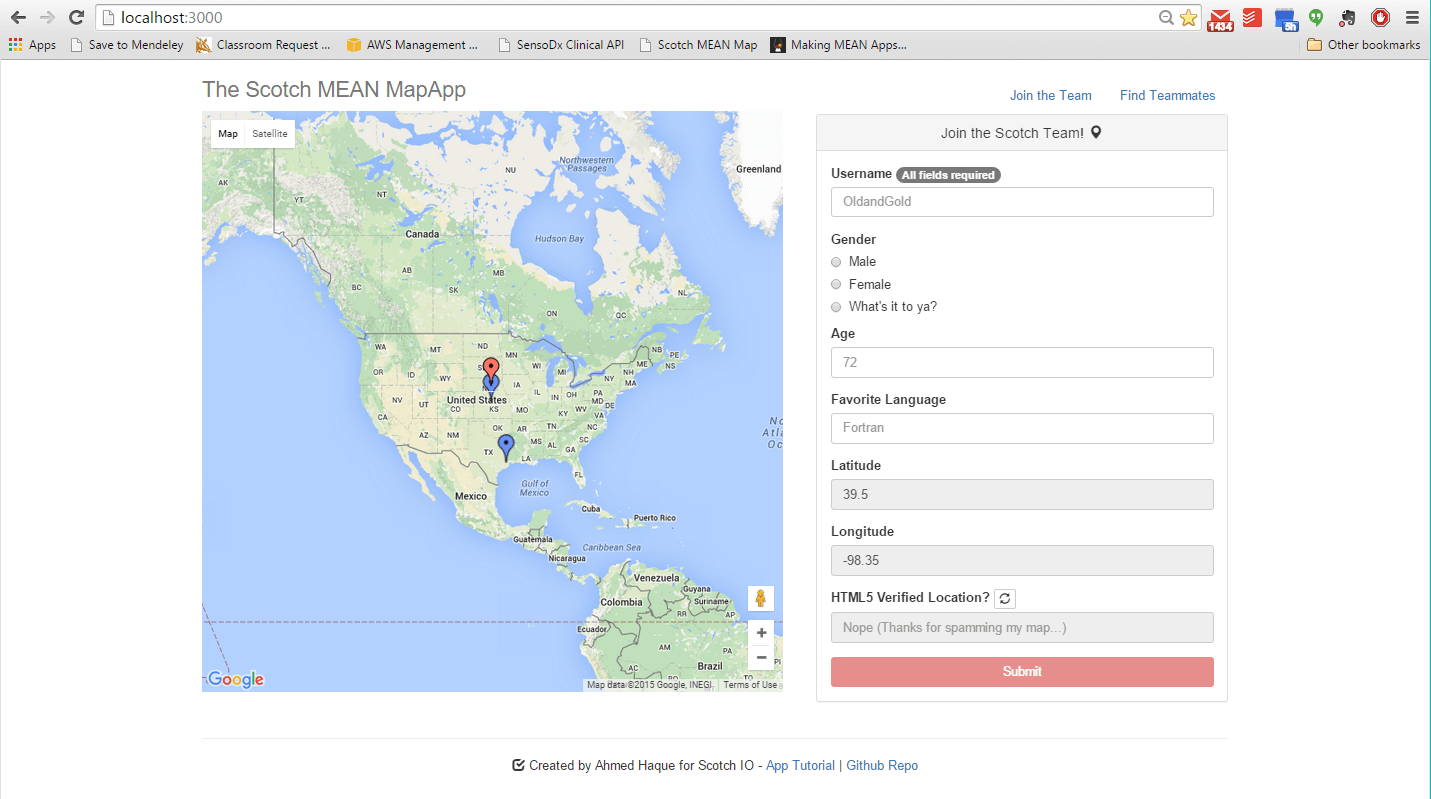
Woohoo! We are mapping now! As a further test, go ahead and click any one of the markers you see. You should see a pop-up window with info.
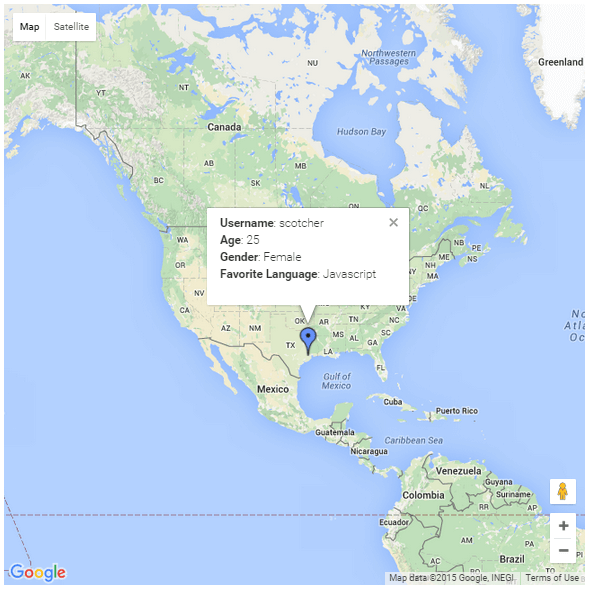
Yay! Now we’re popping now as well!
Adding Clickability
We’ve done some great things here, but right now — there is no way for users to actually set their location on the map before submitting. Everyone is just stuck in the center of Kansas. So let’s create some functionality for map clicks.
First, add the following service properties in the section for initializing variables:
// Handling Clicks and location selection googleMapService.clickLat = 0; googleMapService.clickLong = 0; Next, add the below listener to the bottom of the initialize() function, right under the section that set the initial location as a bouncing red marker.
// Bouncing Red Marker Logic // ... // Function for moving to a selected location map.panTo(new google.maps.LatLng(latitude, longitude)); // Clicking on the Map moves the bouncing red marker google.maps.event.addListener(map, 'click', function(e){ var marker = new google.maps.Marker({ position: e.latLng, animation: google.maps.Animation.BOUNCE, map: map, icon: 'http://maps.google.com/mapfiles/ms/icons/red-dot.png' }); // When a new spot is selected, delete the old red bouncing marker if(lastMarker){ lastMarker.setMap(null); } // Create a new red bouncing marker and move to it lastMarker = marker; map.panTo(marker.position); }); Run your server.js file and test it out. If everything is working, you should be able to move the red dot around the map.
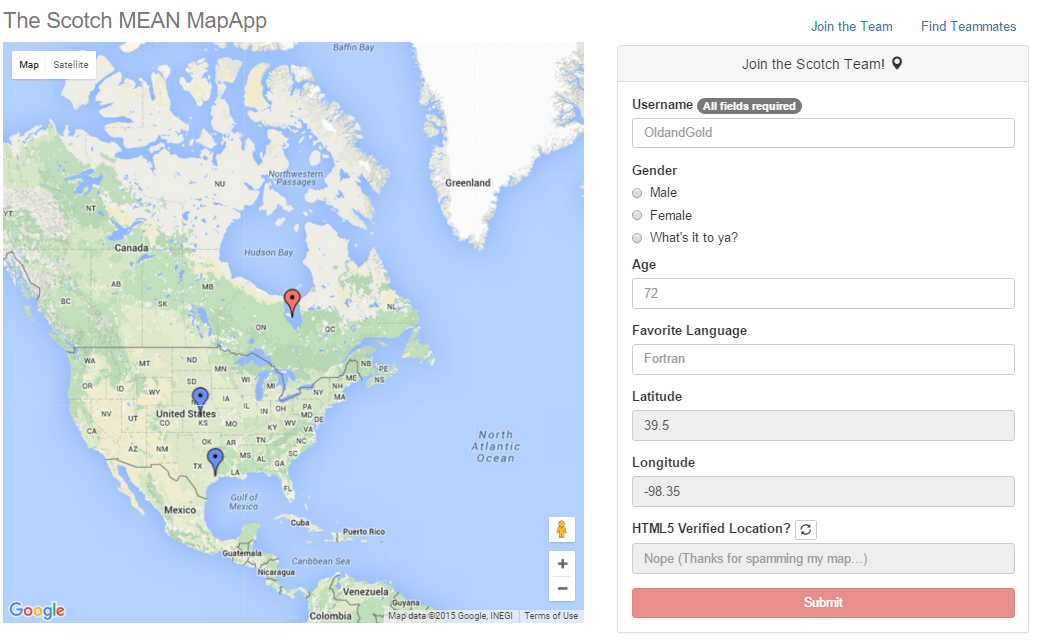
This looks great, but astute readers may have noticed that the coordinates in our form never changed to reflect the dot’s movement. The coordinates always point to Kansas. This makes sense because we never created any logic linking the marker’s movement with our Angular controller. Let’s do that now.
First, let’s add the $ rootScope to the dependency list of the gservice factory. The reason we’re including $ rootScope here is because we’ll be broadcasting the result of clicks back to our original Angular form, so we can see the coordinates clicked onto.
angular.module('gservice', []) .factory('gservice', function($ rootScope, $ http){ Then add the logic associated with the broadcasting to $ rootScope at the conclusion of the map’s click listener event we just created.
// Update Broadcasted Variable (lets the panels know to change their lat, long values) googleMapService.clickLat = marker.getPosition().lat(); googleMapService.clickLong = marker.getPosition().lng(); $ rootScope.$ broadcast("clicked"); Now, return back to the addCtrl.js file and include the $ rootScope service in our addCtrl controller.
addCtrl.controller('addCtrl', function($ scope, $ http, $ rootScope, geolocation, gservice){ Finally, add the below function on top of the createUser function. Here you can see that this function listens for when the gservice function broadcasts the “click” event. On click, the addCtrl controller will set the value of the latitude and longitude of the form equal to the click coordinates (rounded to 3). It will also note that the location has not been HTML Verified (to differentiate between spam and authentic locations).
// Get coordinates based on mouse click. When a click event is detected.... $ rootScope.$ on("clicked", function(){ // Run the gservice functions associated with identifying coordinates $ scope.$ apply(function(){ $ scope.formData.latitude = parseFloat(gservice.clickLat).toFixed(3); $ scope.formData.longitude = parseFloat(gservice.clickLong).toFixed(3); $ scope.formData.htmlverified = "Nope (Thanks for spamming my map...)"; }); }); // Create User Function // ... Go ahead and test it now.
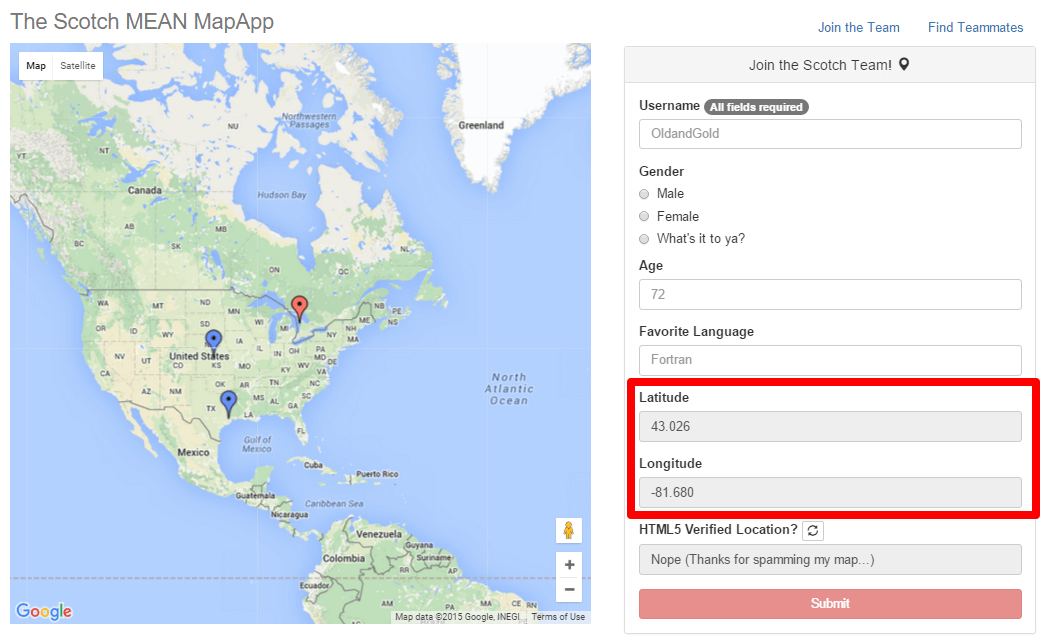
Looking good!
Getting HTML5 Verified Locations
At this point, we have a pretty slick app on our hands. So if you feel like checking-out, I won’t stop you. But for those hungry for the cherry on top, let’s add one last function. Up until now, we’re leaving it to users to provide us with their actual location. This might be fine if we’re okay with crappy, spam data. But if we want a way to discriminate true locations — we need something better.
This is where HTML5 Geolocation comes in. With the latest version of HTML comes the ability to identify precisely where a user is located–so long as they grant permission in the browser. Let’s add one last function to our app that sets the initial location of our user’s dot to their HTML5 verified location.
To do this, we’ll be utilizing the open-source angularjs-geolocation library. The library makes it easy to incorporate HTML5 geolocation requests in Angular applications. Since we’ve already added references to the geolocation service in our addCtrl and app.js files, all we need to do is include the logic associated with such a call in addCtrl. Simply paste the below code in the initialization section of addCtrl.js after the initial coordinates are set.
// Initial Coordinates set // ... // Get User's actual coordinates based on HTML5 at window load geolocation.getLocation().then(function(data){ // Set the latitude and longitude equal to the HTML5 coordinates coords = {lat:data.coords.latitude, long:data.coords.longitude}; // Display coordinates in location textboxes rounded to three decimal points $ scope.formData.longitude = parseFloat(coords.long).toFixed(3); $ scope.formData.latitude = parseFloat(coords.lat).toFixed(3); // Display message confirming that the coordinates verified. $ scope.formData.htmlverified = "Yep (Thanks for giving us real data!)"; gservice.refresh($ scope.formData.latitude, $ scope.formData.longitude); }); The logic here uses a simple geolocation.getLocation function to return coordinate data. This coordinate data is then parsed, rounded to three decimal points (for privacy reasons), and then passed to the $ scope.formData.longitude and $ scope.formData.latitude. Once this takes place, we refresh the map and pass in the newest coordinates to be added.
Let’s test this out. If things went correctly, your browser should have asked you for location access and then moved your red dot near your precise location.
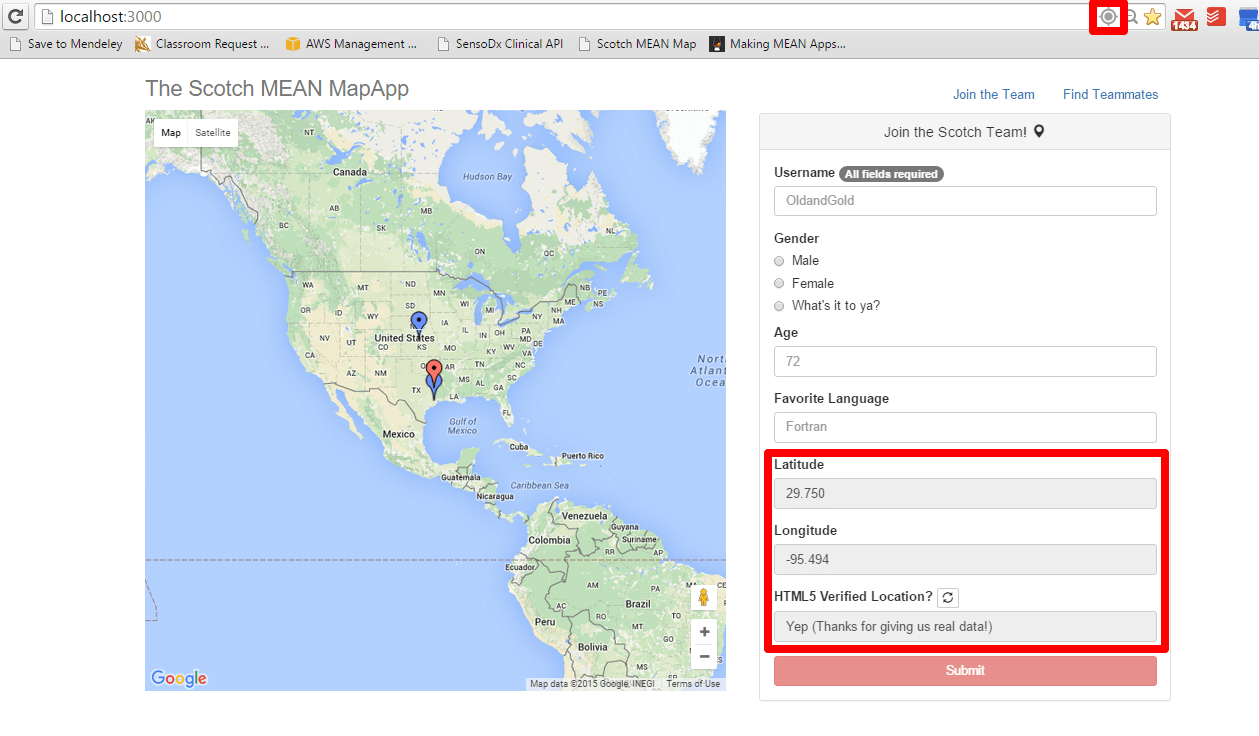
Voila!
… onto Part II!
Phew. We really covered a lot today. But hopefully, this exercise has left you empowered to chart your own map-making path and to lay your mark on the world at large. (Puns definitely intended.)
We’ll be back in a week or so for Part II, where we’ll enhance our newly created Map App with querying and filtering tools. In the meantime, keep experimenting and adding new features at your own pace. Stay tuned!
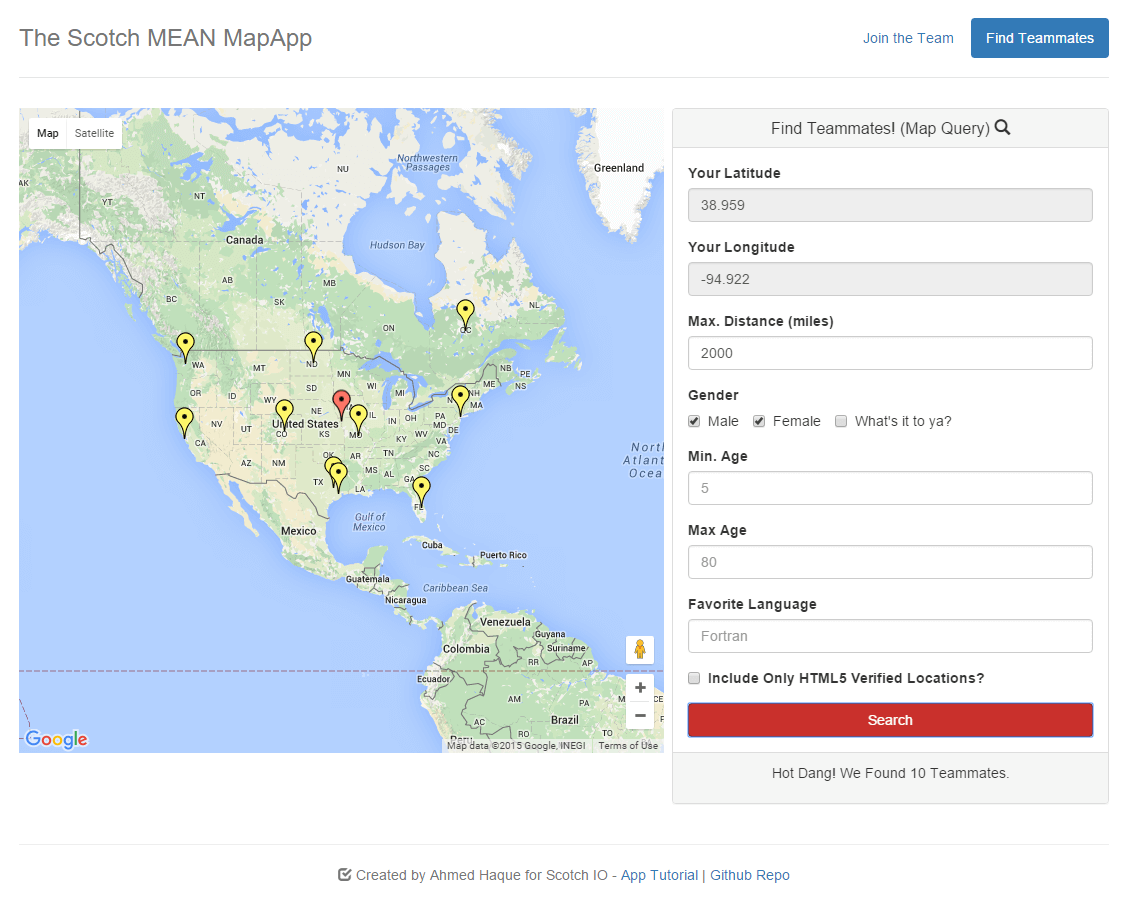
![]()
